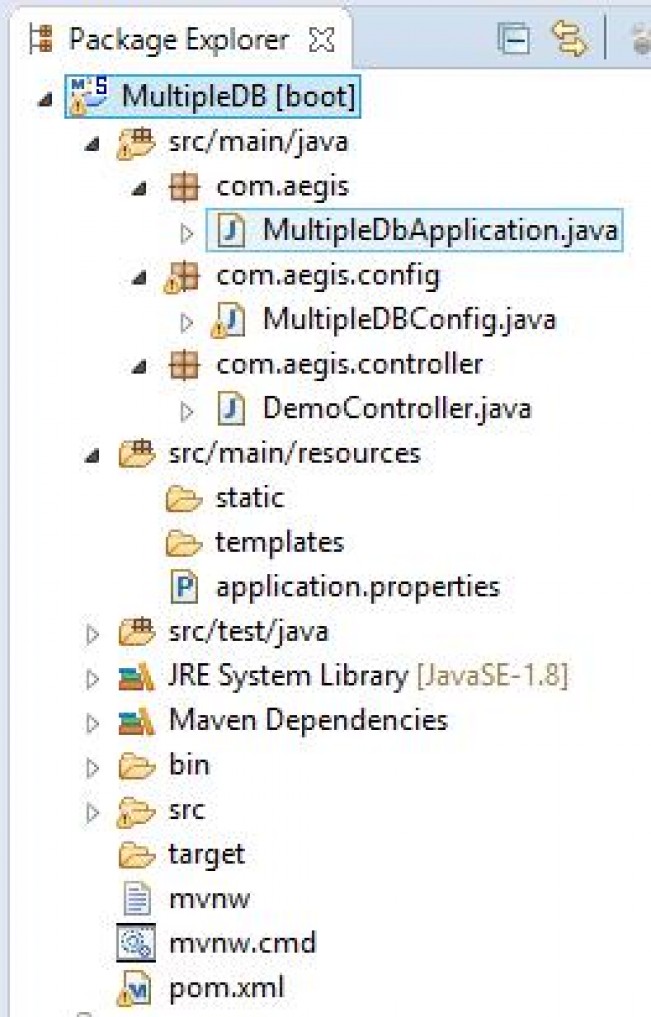Java Spring中同时访问多种不同数据库
开发企业应用时我们常常遇到要同时访问多种不同数据库的问题,有时是必须把数据归档到某种数据仓库中,有时是要把数据变更推送到第三方数据库中。使用Spring框架时,使用单一数据库是非常容易的,但如果要同时访问多个数据库的话事件就变得复杂多了。
本文以在Spring框架下开发一个SpringMVC程序为例,示范了一种同时访问多种数据库的方法,而且尽量地简化配置改动。
搭建数据库
建议你也同时搭好两个数据库来跟进我们的示例。本文中我们用了PostgreSQL和MySQL。
下面的脚本内容是在两个数据库中建表和插入数据的命令。
PostgreSQL
CREATE TABLE usermaster ( id integer, name character varying, emailid character varying, phoneno character varying(10), location character varying ) INSERT INTO usermaster(id, name, emailid, phoneno, location) VALUES (1, 'name_postgres', 'email@email.com', '1234567890', 'IN');
MySQL
CREATE TABLE `usermaster` (
`id` int(11) NOT NULL,
`name` varchar(255) DEFAULT NULL,
`emailid` varchar(20) DEFAULT NULL,
`phoneno` varchar(20) DEFAULT NULL,
`location` varchar(20) DEFAULT NULL,
PRIMARY KEY (`id`)
)
INSERT INTO `kode12`.`usermaster`
(`id`, `name`, `emailid`, `phoneno`, `location`)
VALUES
('1', 'name_mysql', 'test@tset.com', '9876543210', 'IN');
搭建项目
我们用Spring Tool Suite (STS)来构建这个例子:
-
点击File -> New -> Spring Starter Project。
-
在对话框中输入项目名、Maven坐标、描述和包信息等,点击Next。
-
在boot dependency中选择Web,点击Next。
-
点击Finish。STS会自动按照项目依赖关系从Spring仓库中下载所需要的内容。
创建完的项目如下图所示:

接下来我们仔细研究一下项目中的各个相关文件内容。
pom.xml
pom中包含了所有需要的依赖和插件映射关系。
代码:
<?xml version="1.0" encoding="UTF-8"?> <project xmlns="http://maven.apache.org/POM/4.0.0" xmlns:xsi="http://www.w3.org/2001/XMLSchema-instance" xsi:schemaLocation="http://maven.apache.org/POM/4.0.0 http://maven.apache.org/xsd/maven-4.0.0.xsd"> <modelVersion>4.0.0</modelVersion> <groupId>com.aegis</groupId> <artifactId>MultipleDBConnect</artifactId> <version>0.0.1-SNAPSHOT</version> <packaging>jar</packaging> <name>MultipleDB</name> <description>MultipleDB with Spring Boot</description> <parent> <groupId>org.springframework.boot</groupId> <artifactId>spring-boot-starter-parent</artifactId> <version>1.3.5.RELEASE</version> <relativePath /> </parent> <properties> <project.build.sourceEncoding>UTF-8</project.build.sourceEncoding> <java.version>1.8</java.version> </properties> <dependencies> <dependency> <groupId>org.springframework.boot</groupId> <artifactId>spring-boot-starter-web</artifactId> </dependency> <dependency> <groupId>org.springframework.boot</groupId> <artifactId>spring-boot-starter-test</artifactId> <scope>test</scope> </dependency> <dependency> <groupId>org.springframework.boot</groupId> <artifactId>spring-boot-starter-jdbc</artifactId> </dependency> <dependency> <groupId>org.postgresql</groupId> <artifactId>postgresql</artifactId> </dependency> <dependency> <groupId>mysql</groupId> <artifactId>mysql-connector-java</artifactId> <version>5.1.38</version> </dependency> </dependencies> <build> <plugins> <plugin> <groupId>org.springframework.boot</groupId> <artifactId>spring-boot-maven-plugin</artifactId> </plugin> </plugins> </build> </project>
解释:
下面详细解释各种依赖关系的细节:
-
spring-boot-starter-web:为Web开发和MVC提供支持。
-
spring-boot-starter-test:提供JUnit、Mockito等测试依赖。
-
spring-boot-starter-jdbc:提供JDBC支持。
-
postgresql:PostgreSQL数据库的JDBC驱动。
-
mysql-connector-java:MySQL数据库的JDBC驱动。
application.properties
包含程序需要的所有配置信息。在旧版的Spring中我们要通过多个XML文件来提供这些配置信息。
server.port=6060 spring.ds_post.url =jdbc:postgresql://localhost:5432/kode12 spring.ds_post.username =postgres spring.ds_post.password =root spring.ds_post.driverClassName=org.postgresql.Driver spring.ds_mysql.url = jdbc:mysql://localhost:3306/kode12 spring.ds_mysql.username = root spring.ds_mysql.password = root spring.ds_mysql.driverClassName=com.mysql.jdbc.Driver
解释:
“server.port=6060”声明你的嵌入式服务器启动后会使用6060端口(port.server.port是Boot默认的标准端口)。
其他属性中:
-
以“spring.ds_*”为前缀的是用户定义属性。
-
以“spring.ds_post.*”为前缀的是为PostgreSQL数据库定义的属性。
-
以“spring.ds_mysql.*”为前缀的是为MySQL数据库定义的属性。
MultipleDbApplication.java
package com.aegis;
import org.springframework.boot.SpringApplication;
import org.springframework.boot.autoconfigure.SpringBootApplication;
@SpringBootApplication
public MultipleDbApplication {
public static void main(String[] args) {
SpringApplication.run(MultipleDbApplication.class, args);
}
}
这个文件包含了启动我们的Boot程序的主函数。注解“@SpringBootApplication”是所有其他Spring注解和 Java注解 的组合,包括:
@Configuration
@EnableAutoConfiguration
@ComponentScan
@Target(value={TYPE})
@Retention(value=RUNTIME)
@Documented
@Inherited
其他注解:
@Configuration
@EnableAutoConfiguration
@ComponentScan
上述注解会让容器通过这个类来加载我们的配置。
MultipleDBConfig.java
package com.aegis.config;
import javax.sql.DataSource;
import org.springframework.beans.factory.annotation.Qualifier;
import org.springframework.boot.autoconfigure.jdbc.DataSourceBuilder;
import org.springframework.boot.context.properties.ConfigurationProperties;
import org.springframework.context.annotation.Bean;
import org.springframework.context.annotation.Configuration;
import org.springframework.context.annotation.Primary;
import org.springframework.jdbc.core.JdbcTemplate;
@Configuration
public class MultipleDBConfig {
@Bean(name = "mysqlDb")
@ConfigurationProperties(prefix = "spring.ds_mysql")
public DataSource mysqlDataSource() {
return DataSourceBuilder.create().build();
}
@Bean(name = "mysqlJdbcTemplate")
public JdbcTemplate jdbcTemplate(@Qualifier("mysqlDb") DataSource dsMySQL) {
return new JdbcTemplate(dsMySQL);
}
@Bean(name = "postgresDb")
@ConfigurationProperties(prefix = "spring.ds_post")
public DataSource postgresDataSource() {
return DataSourceBuilder.create().build();
}
@Bean(name = "postgresJdbcTemplate")
public JdbcTemplate postgresJdbcTemplate(@Qualifier("postgresDb")
DataSource dsPostgres) {
return new JdbcTemplate(dsPostgres);
}
}
解释:
这是加了注解的配置类,包含加载我们的PostgreSQL和MySQL数据库配置的函数和注解。这也会负责为每一种数据库创建JDBC模板类。
下面我们看一下这四个函数:
@Bean(name = "mysqlDb")
@ConfigurationProperties(prefix = "spring.ds_mysql")
public DataSource mysqlDataSource() {
return DataSourceBuilder.create().build();
}
上面代码第一行创建了mysqlDb bean。
第二行帮助@Bean加载了所有有前缀spring.ds_mysql的属性。
第四行创建并初始化了DataSource类,并创建了mysqlDb DataSource对象。
@Bean(name = "mysqlJdbcTemplate")
public JdbcTemplate jdbcTemplate(@Qualifier("mysqlDb") DataSource dsMySQL) {
return new JdbcTemplate(dsMySQL);
}
第一行以mysqlJdbcTemplate为名创建了一个JdbcTemplate类型的新Bean。
第二行将第一行中创建的DataSource类型新参数传入函数,并以mysqlDB为qualifier。
第三行用DataSource对象初始化JdbcTemplate实例。
@Bean(name = "postgresDb")
@ConfigurationProperties(prefix = "spring.ds_post")
public DataSource postgresDataSource() {
return DataSourceBuilder.create().build();
}
第一行创建DataSource实例postgresDb。
第二行帮助@Bean加载所有以spring.ds_post为前缀的配置。
第四行创建并初始化DataSource实例postgresDb。
@Bean(name = "postgresJdbcTemplate")
public JdbcTemplate postgresJdbcTemplate(@Qualifier("postgresDb")
DataSource dsPostgres) {
return new JdbcTemplate(dsPostgres);
}
第一行以postgresJdbcTemplate为名创建JdbcTemplate类型的新bean。
第二行接受DataSource类型的参数,并以postgresDb为qualifier。
第三行用DataSource对象初始化JdbcTemplate实例。
DemoController.java
package com.aegis.controller;
import java.util.HashMap;
import java.util.Map;
import org.springframework.beans.factory.annotation.Autowired;
import org.springframework.beans.factory.annotation.Qualifier;
import org.springframework.jdbc.core.JdbcTemplate;
import org.springframework.web.bind.annotation.PathVariable;
import org.springframework.web.bind.annotation.RequestMapping;
import org.springframework.web.bind.annotation.RestController;
@RestController
public class DemoController {
@Autowired
@Qualifier("postgresJdbcTemplate")
private JdbcTemplate postgresTemplate;
@Autowired
@Qualifier("mysqlJdbcTemplate")
private JdbcTemplate mysqlTemplate;
@RequestMapping(value = "/getPGUser")
public String getPGUser() {
Map<String, Object> map = new HashMap<String, Object>();
String query = " select * from usermaster";
try {
map = postgresTemplate.queryForMap(query);
} catch (Exception e) {
e.printStackTrace();
}
return "PostgreSQL Data: " + map.toString();
}
@RequestMapping(value = "/getMYUser")
public String getMYUser() {
Map<String, Object> map = new HashMap<String, Object>();
String query = " select * from usermaster";
try {
map = mysqlTemplate.queryForMap(query);
} catch (Exception e) {
e.printStackTrace();
}
return "MySQL Data: " + map.toString();
}
}
解释:
@RestController类注解表明这个类中定义的所有函数都被默认绑定到响应中。
上面代码段创建了一个JdbcTemplate实例。@Qualifier用于生成一个对应类型的模板。代码中提供的是postgresJdbcTemplate作为Qualifier参数,所以它会加载MultipleDBConfig实例的jdbcTemplate(…)函数创建的Bean。
这样Spring就会根据你的要求来调用合适的JDBC模板。在调用URL “/getPGUser”时Spring会用PostgreSQL模板,调用URL “/getMYUser”时Spring会用MySQL模板。
@Autowired
@Qualifier ( "postgresJdbcTemplate")
private
JdbcTemplate postgresTemplate;
这里我们用queryForMap(String query)函数来使用JDBC模板从数据库中获取数据,queryForMap(…)返回一个map,以字段名为Key,Value为实际字段值。
演示
执行类MultipleDbApplication中的main (…)函数就可以看到演示效果。在你常用的浏览器中点击下面URL:
URL: http://localhost:6060/getMYUser
上面的URL会查询MySQL数据库并以字符串形式返回数据。

Url: http://localhost:6060/getPGUser
上面的URL会查询PostgreSQL数据库并以字符串形式返回数据。

关于作者
Aaron Jacobson是个经验丰富的Java Web 程序员 ,在外包与咨询公司Technoligent担任Java开发程序员10年以上。他的主要贡献包括Java、Python、Asp.Net和手机应用等一系列Web解决方案。可以通过Twitter @Techno_Ligent或Facebook @TechnoLigent联系他。
【责任编辑:seeker TEL:(010)68476606】
- 本文标签: 插件 dataSource python Master root mail map 程序员 SpringMVC 企业 ACE IO web pom sql App value Developer Word java注解 apache maven cat CTO key 对象初始化 http plugin java db 数据库 代码 开发 core ORM spring 端口 description Facebook XML dependencies src bean mysql tab tar 数据 实例 参数 build Twitter 测试 UI Select REST schema 下载 id 服务器 ip 配置 Document
- 版权声明: 本文为互联网转载文章,出处已在文章中说明(部分除外)。如果侵权,请联系本站长删除,谢谢。
- 本文海报: 生成海报一 生成海报二











![[HBLOG]公众号](https://www.liuhaihua.cn/img/qrcode_gzh.jpg)

